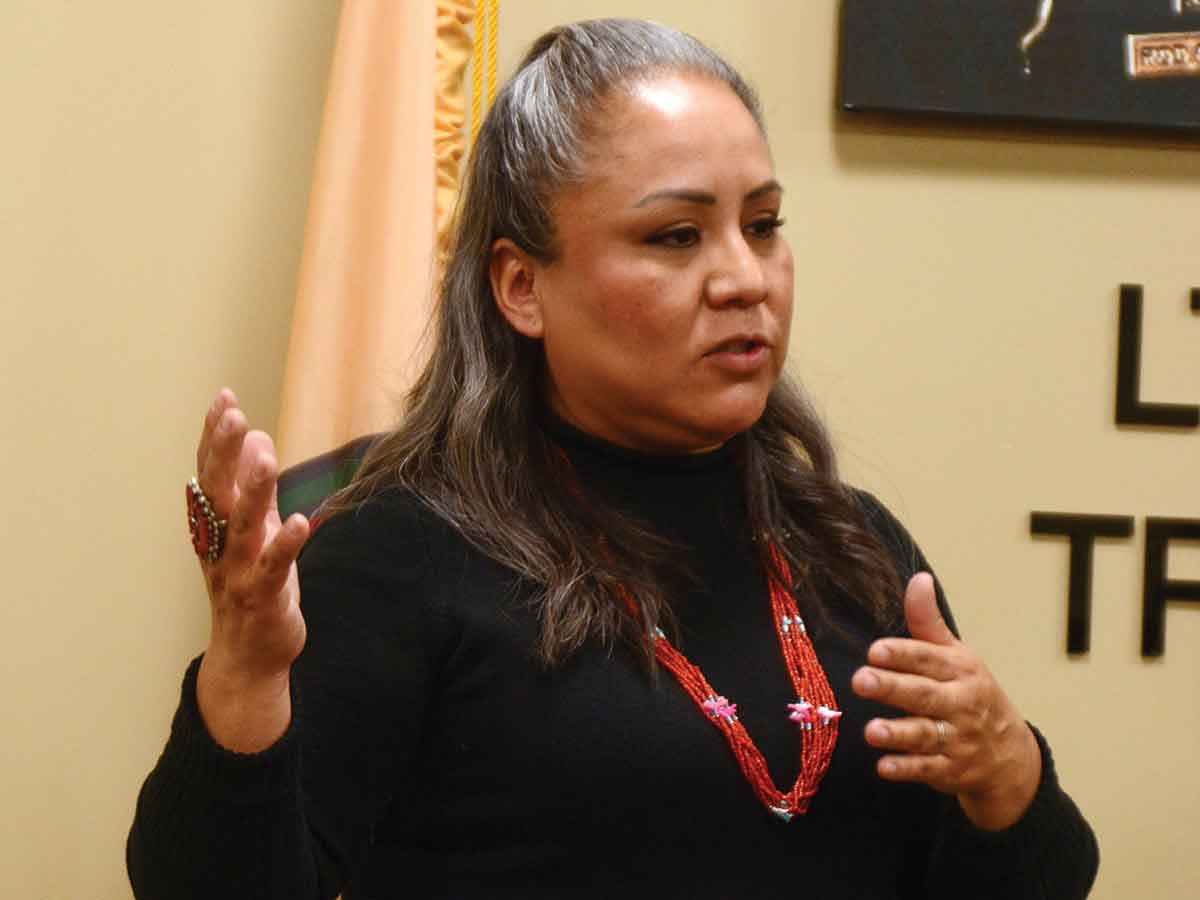Ready for the worst: Cherokee police receive toolkit to aid AMBER Alert response
 Tyesha Wood, program director for the AMBER Alert in Indian Country Initiative, speaks to the unique challenges facing tribal law enforcement. Holly Kays photo
Tyesha Wood, program director for the AMBER Alert in Indian Country Initiative, speaks to the unique challenges facing tribal law enforcement. Holly Kays photo
When a child goes missing, the first 48 hours are the most critical portion of the response. If it ever happens on the Qualla Boundary, the Cherokee Indian Police Department wants to be ready to hit the ground running the moment the call comes through — and an award from the The AMBER Advocate’s Amber Alert in Indian Country Initiative aims to ensure officers are ready should the worst occur.
“It provides us the training and the equipment to be successful in Indian country,” Cherokee Police Chief Josh Taylor said of the award. “A lot of times, there’s barriers and divisions between native lands and state lands, and I want to tear those walls down. And this is a first step of us moving forward doing that.”
Taylor spoke during a March 22 presentation event attended by CIPD and N.C. State Highway Patrol officers, as well as leaders from the AAII program. The Eastern Band of Cherokee Indians is now one of a dozen tribes — out of 574 nationwide — to receive a toolkit from the initiative, through funding from the U.S. Department of Justice.
The kit , packaged in a rugged Pelican Protector case, includes a Panasonic Toughbook tablet loaded with key contacts and checklists, as well as a headset, webcam, document scanner, digital camera, flash memory card, camera case, camera battery and an HDMI cable. The award also gives the tribe access to resources and trainings through AMBER Advocate. If a child should be reported missing, responding officers can grab the kit and have everything they need to send out an alert as quickly as possible while still in the field.
“All of Indian country is not the same, so everybody’s challenges are different,” said Tyesha Wood, AAII’s project coordinator, who is also a member of the Navajo Nation and a former police detective. “There are probably other things that you can think of that would benefit your community, but in general we feel like this best helps all of Indian country.”
Related Items

Members of the N.C. State Highway Patrol (left) and Cherokee Indian Police Department stand with the newly awarded technology toolkit. Holly Kays photo
In 2016, Wood’s tribe suffered a tragedy that showcased the challenges Native American tribes face in responding to missing child reports. On May 2, 2016, 11-year-old Ashlynne Mike was kidnapped and killed near Shiprock on the Navajo Nation Reservation. The 27,000-square-mile Navajo reservation stretches from Arizona to Utah, and tribal law enforcement officers did not have an AMBER Alert plan in place to notify people living across that vast distance. Thirteen hours passed before an Amber Alert was issued.
After her daughter’s death, Mike’s mother Pamela Foster fought for legislation preventing tragedies like hers from happening again. Two years later, the AMBER Alert in Indian Country Act passed, with multiple provisions aimed at addressing the issues that surfaced in Mike’s case. The act allows for tribal AMBER alert systems to be integrated with state systems, makes Indian tribes eligible for AMBER Alert grants, permits use of grant funds to integrate state and regional AMBER Alert communication plans with Indian tribes and allows for a waiver of the matching funds requirement when grants are awarded to Indian tribes.
All tribes are unique, and so are their challenges. But lacking or nonexistent partnerships between tribes and state and federal law enforcement are a key roadblock. Every tribe is a sovereign nation, so they’re not automatically connected to the network of training and resources that their neighbors in other jurisdictions have at their disposal. Some tribes don’t even have access to the National Crime Information Center , which allows law enforcement agencies nationwide to be notified of missing person cases occurring anywhere in the country. If a tribe lacks access to that database, then it must rely on state partners to submit its missing person report. When tribal officials and state officials don’t have an existing relationship — or even vital information like cell phone numbers — the resulting time lag in issuing the alert can turn deadly for the child.
Wood said that the close working relationship between CIPD and the NCSHP is “unique” in her experience working with tribes. In Mike’s case, the tribe did not have a direct relationship with the state AMBER Alert coordinator, resulting in the extreme delay in issuing that alert. Some coordinators, she said, aren’t even aware that there is a sovereign tribe in their state.

Nona Best, director of the N.C. Center for Missing Persons, is a key partner to the CIPD in missing persons cases. Holly Kays photo
Fortunately, that’s not the case in North Carolina, said Nona Best, director of the N.C. Center for Missing Persons.
“We have a good working relationship, and we will continue training together and communicating together and sharing our tools so that we can ensure that if a child does go missing, that we have that gap filled and we don’t have to worry about a long lag time between reporting someone missing or reporting an Amber Alert,” she said.
The challenges may seem simple, but when a child goes missing, they’re momentous, Wood said.
That means that front-end preparation, whether through the purchase of equipment, completion of training, or connections between partners, can be lifesaving.
“By preparing and training and planning, we are ready if our worst nightmare occurs and becomes a reality, and we’re prepared to respond instead of trying to figure everything out when we get that call,” said Janell Rasmussen, program administrator for the AMBER Alert Training and Technical Assistance Program. “We’d like to provide resources and training so that people, agencies, communities are ready during these chaotic times.”









